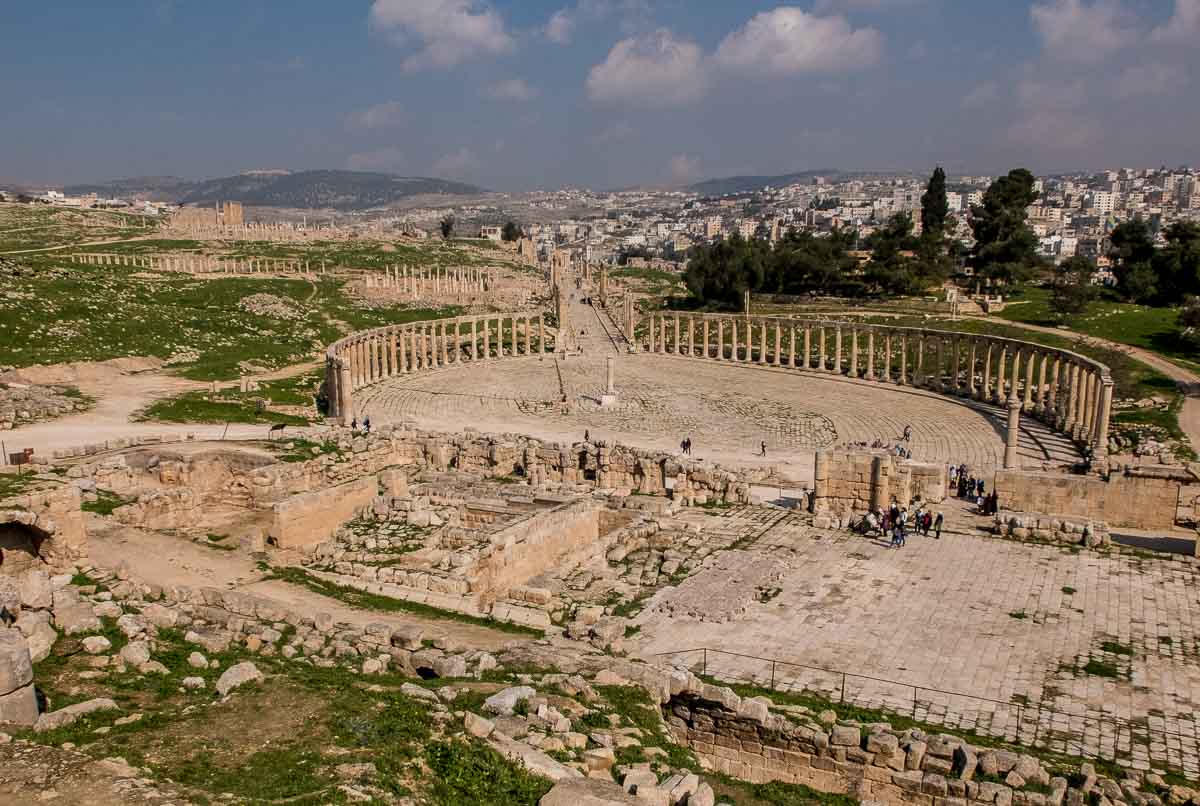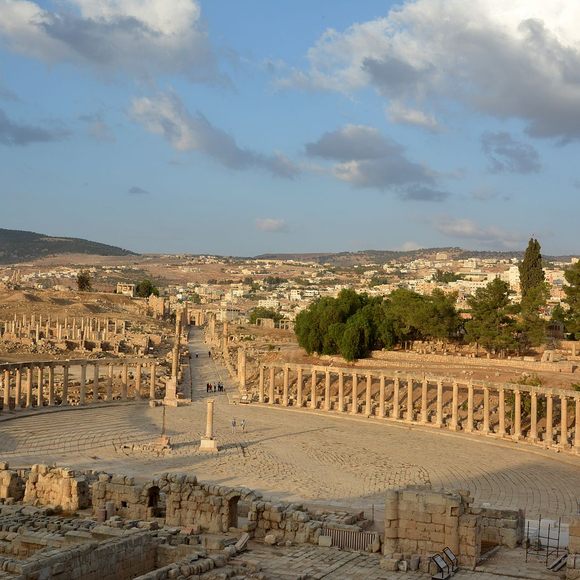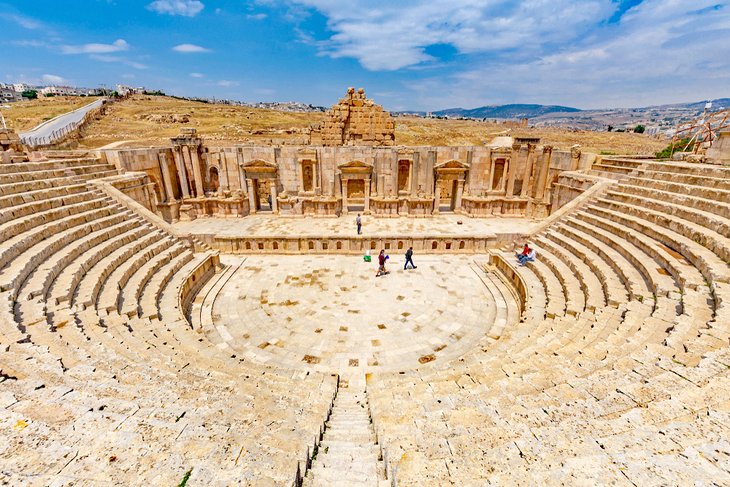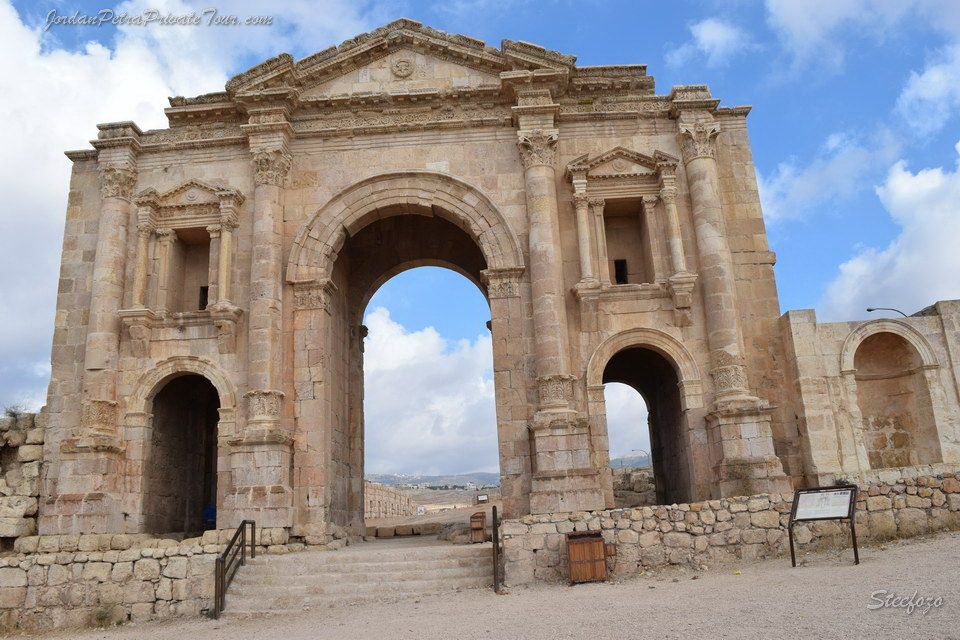Jerash Ruins: A Comprehensive Guide to Jordan's Most Famous Archaeological Site
May 23
As you wander through the ancient ruins of Jerash, you cannot help but feel in awe of this historic city's sheer magnitude and preservation. With a history dating back to the 1st century, Jerash was once a thriving centre of trade and culture in the heart of the Middle East. Today, the Jerash ruins serve as a window into the past, allowing visitors to experience life in ancient times like never before. From the towering pillars of the Temple of Artemis to the intricately-carved facades of the Roman Theatre, Jerash is a truly unique and unforgettable destination for history buffs and curious travellers alike. Are you ready to journey through time at the Jerash ruins? Let's dive in!

Introduction to Jerash Ruins in Jordan
Welcome to Jerash, one of the grandest ancient Roman cities in the world, located in Jordan. This spectacular site is a must-visit destination for anyone travelling to Jordan. Jerash is a well-preserved city with ruins from the Roman conquest that is relatively well-maintained, giving visitors a glimpse of its glorious past. The city was built in the 1st and 7th centuries and flourished due to its fertile soil and trade with Nabateans travelling around Jerash from Petra. In its heyday, around 20,000 people lived in Jerash. The city's decline began in 747 when an earthquake struck, and it gradually lost its importance. The site was abandoned by the 12th century until it was rediscovered in the 19th century, and restoration began. Jerash is recognized as one of the most powerful Greco-Roman settlements in the region and is now the second most visited place in Jordan. It has a bustling touristy attraction filled with restaurants and souvenir shops, making Jerash a well-rounded visitor experience. Experience the Jerash ruins' historical and cultural significance by walking around the temples, water fountains, plazas, theatres, columns, and arches. To enjoy the site without the crowds, arriving early in the morning or visiting during the off-peak season is best. Before heading to the ticket office, stroll through the hall filled with souvenir shops and grab a cool drink or coffee from the outdoor café at the site entrance. When exploring the ruins, wear comfortable clothes, a sunhat, and sunscreen, and bring lots of water since there is little protection from the desert sun. Purchasing a Jordan Pass is advisable, as it waives visa fees and covers the entrance fee to Jerash ruins. In conclusion, we hope this post inspires you to visit Jerash ruins and experience its amazing heritage and culture. [1][2]

History of Jerash from the Neolithic period to Ottoman rule
Welcome to the history of Jerash, one of Jordan's most fascinating ancient sites. The ruins of the Greco-Roman city of Gerasa, also known as Antioch on the Golden River, date back to the Neolithic period, around 7500 BC. In 2015, archaeologists excavated two human skulls from this period, which is rare evidence of human settlements in Jordan. Jerash's history is extensive, from the Bronze Age settlements to the Roman Empire's annexation of the city in 63 BC. The city was absorbed into the Roman province of Arabia in AD 106, along with Petra and Bostra. The Romans brought security and stability, allowing their people to develop the economy and civic building activity. By the Byzantine period, Jerash measured 800,000 square meters within its walls and was a centre for ceramics. The Byzantine church built in AD 530 has ancient Greek and Hebrew-Aramaic inscriptions beneath its foundations, indicating that the area may have previously been a synagogue. The Umayyad Caliphate period flourished with numerous shops and a sizable Muslim community co-existing with Christians. The city lost many buildings and monuments in CE 749 due to a devastating earthquake. It was then deserted until the early 16th century, during the Ottoman era. The small hamlet in the Northwest Quarter shows that Jerash was resettled before the Ottoman period. The Middle Islamic period's excavation since 2011 uncovered a large concentration of structures and pottery. Today, Jerash is home to one of the best preserved Greco-Roman cities, the "Pompeii of the East." It is also home to one of the Middle East's leading cultural events, attracting tens of thousands of visitors. [3][4]

Settlements and archaeological discoveries at Jerash
Welcome to Jerash, Jordan's largest and most fascinating Roman site! In this guide, we'll explore the settlements and archaeological discoveries at Jerash, giving you a glimpse into the area's rich history.
First, let's start with the settlements. Archaeologists have found ruins dating back to the Neolithic Age, with evidence of human inhabitation from 7500-5500 BC. At the Ain Ghazal Neolithic settlement in Amman, two human skulls were unearthed in 2015, which is a rare discovery given that only 12 similar human remains worldwide exist. Some ruins from the Bronze Age have also been discovered, but no Iron Age material so far has been documented.
Moving on to the Greco-Roman city of Gerasa, also called Antioch on the Golden River. Alexander the Great and his general Perdiccas are believed to have founded the city in 331 BC, where they settled aged Macedonian soldiers. Some sources also attribute the founding to Ptolemy II of Egypt or Seleucid King Antioch IV. After the Roman conquest in 63 BC, Jerash and the surrounding lands became part of the Roman province of Syria and later joined the Decapolis League of cities.
The city of Jerash reached about 800,000 square meters within its walls, with numerous shops and civic buildings. The city had a sizable Muslim community co-existing with the Christians during the Umayyad period, indicated by a large mosque and several churches.
Jerash was devastated by a massive earthquake in 749 CE, which destroyed much of the city and its surroundings. Later, in the 12th century, a fortress was built by a garrison stationed in the area, which was burned down by Baldwin II, King of Jerusalem, in 1121-1122 CE.
Today, Jerash has become one of Jordan's most popular tourist destinations, attracting approximately 330,000 visitors in 2018. It is home to one of the best-preserved Greco-Roman cities, earning it the nickname "Pompeii of the Middle East" or "Rome of Asia."
As you explore the incredible ruins of Jerash, let your imagination travel back in time to the ancient world of the Greeks, Romans, and Umayyads. Don't forget to bring your camera and capture the awe-inspiring beauty of the city's archaeological wonders. We hope you have a fantastic time in Jerash! [5][6]
First, let's start with the settlements. Archaeologists have found ruins dating back to the Neolithic Age, with evidence of human inhabitation from 7500-5500 BC. At the Ain Ghazal Neolithic settlement in Amman, two human skulls were unearthed in 2015, which is a rare discovery given that only 12 similar human remains worldwide exist. Some ruins from the Bronze Age have also been discovered, but no Iron Age material so far has been documented.
Moving on to the Greco-Roman city of Gerasa, also called Antioch on the Golden River. Alexander the Great and his general Perdiccas are believed to have founded the city in 331 BC, where they settled aged Macedonian soldiers. Some sources also attribute the founding to Ptolemy II of Egypt or Seleucid King Antioch IV. After the Roman conquest in 63 BC, Jerash and the surrounding lands became part of the Roman province of Syria and later joined the Decapolis League of cities.
The city of Jerash reached about 800,000 square meters within its walls, with numerous shops and civic buildings. The city had a sizable Muslim community co-existing with the Christians during the Umayyad period, indicated by a large mosque and several churches.
Jerash was devastated by a massive earthquake in 749 CE, which destroyed much of the city and its surroundings. Later, in the 12th century, a fortress was built by a garrison stationed in the area, which was burned down by Baldwin II, King of Jerusalem, in 1121-1122 CE.
Today, Jerash has become one of Jordan's most popular tourist destinations, attracting approximately 330,000 visitors in 2018. It is home to one of the best-preserved Greco-Roman cities, earning it the nickname "Pompeii of the Middle East" or "Rome of Asia."
As you explore the incredible ruins of Jerash, let your imagination travel back in time to the ancient world of the Greeks, Romans, and Umayyads. Don't forget to bring your camera and capture the awe-inspiring beauty of the city's archaeological wonders. We hope you have a fantastic time in Jerash! [5][6]

Tourist attractions at Jerash: Roman Ruins
Jerash Roman Ruins is one of the top tourist attractions in Jordan, just 48km north of Amman. Jerash is an ancient city that dates back to the Neolithic period, around 7500 to 5500 BC. The city was built during the Hellenistic and Roman periods, which explains the architectural style of the ruins. Jerash is famous for being one of the best-preserved Greco-Roman cities in the Middle East. Walking around the city, you will see amazing 2000-year-old structures, grand avenues, and countless columns with their intricate Corinthian capitals. One of the top sights is Hadrian's Arch, built to celebrate the visit of Emperor Hadrian. Another is the Temple of Artemis, which has stunning columns. You will also find the Oval Forum, the Cardo Maximus Street, the Nymphaeum fountain, and the partially restored Hippodrome stadium.
Jerash experienced a long era of greatness during the Roman Empire's rule, where it became an important trading hub on the King's Highway, an ancient trade route linking Egypt with the Red Sea Philadelphia (Amman) and Damascus. The expanding Roman Empire annexed the city in the 1st century BC and built many of the structures we see today. In 749 AD, Jerash suffered a massive earthquake that destroyed much of the city and never regained its prominence. Archaeologists discovered the ruins in 1806, and since then, the excavation of the ancient city has been almost continuous.
Visiting Jerash Roman Ruins can be easily done in a day, but it is worth taking your time to stroll around the site. Wear comfortable walking shoes and a cap as it can get hot during the day. The entrance fee for foreigners is 12 JD, and the opening hours vary throughout the year. During winter, the site opens at 8 AM and closes at 4 PM, while in summer, you can stay until 8 PM. The site closes earlier on Fridays and national holidays, usually around 4 PM. If you plan to visit other major sites in the country, buying the Jordan Pass before you arrive is worth buying. It will cover your visa fees and entrance ticket to most major sites, including Jerash ruins.
Jerash Roman Ruins is a must-visit attraction in Jordan, alongside Petra and Wadi Rum. As you transport back in time, you will be mesmerized by the ancient structures, breathtaking columns, and stunning plazas. It is touristy, but you'll avoid most crowds if you start your day early. Jerash ruins are one of the best-preserved archaeological sites in the Middle East, so take your time wandering through history and be awe-struck. [7][8]
Jerash experienced a long era of greatness during the Roman Empire's rule, where it became an important trading hub on the King's Highway, an ancient trade route linking Egypt with the Red Sea Philadelphia (Amman) and Damascus. The expanding Roman Empire annexed the city in the 1st century BC and built many of the structures we see today. In 749 AD, Jerash suffered a massive earthquake that destroyed much of the city and never regained its prominence. Archaeologists discovered the ruins in 1806, and since then, the excavation of the ancient city has been almost continuous.
Visiting Jerash Roman Ruins can be easily done in a day, but it is worth taking your time to stroll around the site. Wear comfortable walking shoes and a cap as it can get hot during the day. The entrance fee for foreigners is 12 JD, and the opening hours vary throughout the year. During winter, the site opens at 8 AM and closes at 4 PM, while in summer, you can stay until 8 PM. The site closes earlier on Fridays and national holidays, usually around 4 PM. If you plan to visit other major sites in the country, buying the Jordan Pass before you arrive is worth buying. It will cover your visa fees and entrance ticket to most major sites, including Jerash ruins.
Jerash Roman Ruins is a must-visit attraction in Jordan, alongside Petra and Wadi Rum. As you transport back in time, you will be mesmerized by the ancient structures, breathtaking columns, and stunning plazas. It is touristy, but you'll avoid most crowds if you start your day early. Jerash ruins are one of the best-preserved archaeological sites in the Middle East, so take your time wandering through history and be awe-struck. [7][8]

Triumphal Arch and Hippodrome at Jerash
When you visit the ancient ruins of Jerash, one of the highlights you should check out is the Triumphal Arch and Hippodrome. The Triumphal Arch was built in AD 129 in honour of Emperor Hadrian's visit to the city. It is a remarkable sight with its grand size and unusual shape. It is also one of the four entrances to the main city, and it is located behind the Hippodrome. The Hippodrome was used for chariot races and could accommodate up to 15,000 spectators. It is truly astonishing how large and grand this ancient structure was.
Aside from the Triumphal Arch and Hippodrome, Jerash also has many other impressive sites. You can check out the Temple of Zeus, a grand and elegant structure built around 162. You can also visit the restored North Theater, built in the 1st century with a seating capacity of 5,000 spectators. The acoustics from the upper ranks are still amazing, as some occasional roving minstrels or drummers can demonstrate to you. Another must-see is the 800 m-long collonaded street, also known as the Cardo Maximus, which is punctuated by the main city fountain before giving rise to an impressive monumental gate and a staircase leading to the Temple of Artemis. The temple, unfortunately, was dismantled to make masonry for new churches in 386 under Theodosius.
The Triumphal Arch and Hippodrome are just a small part of Jerash's many wonders. On your visit to the ancient city, you will learn about its rich history, which spans from the Neolithic period to the Ottoman era. You will also marvel at how well-preserved Greek and Roman architecture is in the Middle East. With approximately 330,000 visitors arriving in Jerash in 2018, the city has become one of the most visited sites in Jordan. It is also home to one of the leading cultural events in the Middle East, attracting tens of thousands of visitors annually.
So, when you visit Jerash, stroll through the Triumphal Arch and Hippodrome. You will be amazed by the sheer size and structure of these ancient wonders, and it is certainly worth the climb to get a stunning view of the whole area. Don't forget to explore the other amazing sites as well, and immerse yourself in Jordan's rich history and culture. [9][10]
Aside from the Triumphal Arch and Hippodrome, Jerash also has many other impressive sites. You can check out the Temple of Zeus, a grand and elegant structure built around 162. You can also visit the restored North Theater, built in the 1st century with a seating capacity of 5,000 spectators. The acoustics from the upper ranks are still amazing, as some occasional roving minstrels or drummers can demonstrate to you. Another must-see is the 800 m-long collonaded street, also known as the Cardo Maximus, which is punctuated by the main city fountain before giving rise to an impressive monumental gate and a staircase leading to the Temple of Artemis. The temple, unfortunately, was dismantled to make masonry for new churches in 386 under Theodosius.
The Triumphal Arch and Hippodrome are just a small part of Jerash's many wonders. On your visit to the ancient city, you will learn about its rich history, which spans from the Neolithic period to the Ottoman era. You will also marvel at how well-preserved Greek and Roman architecture is in the Middle East. With approximately 330,000 visitors arriving in Jerash in 2018, the city has become one of the most visited sites in Jordan. It is also home to one of the leading cultural events in the Middle East, attracting tens of thousands of visitors annually.
So, when you visit Jerash, stroll through the Triumphal Arch and Hippodrome. You will be amazed by the sheer size and structure of these ancient wonders, and it is certainly worth the climb to get a stunning view of the whole area. Don't forget to explore the other amazing sites as well, and immerse yourself in Jordan's rich history and culture. [9][10]
